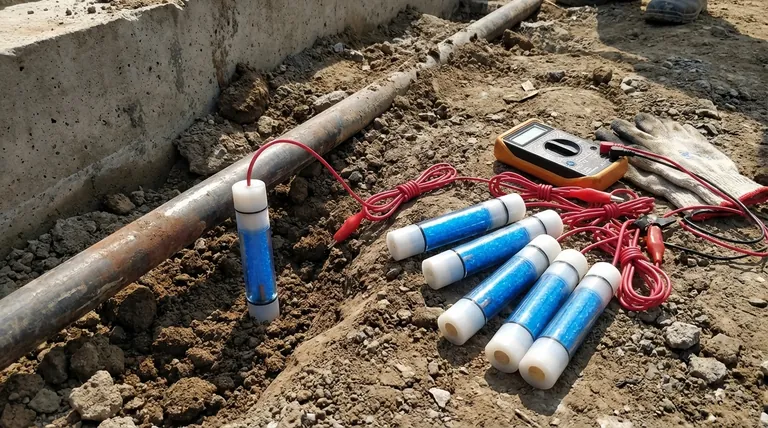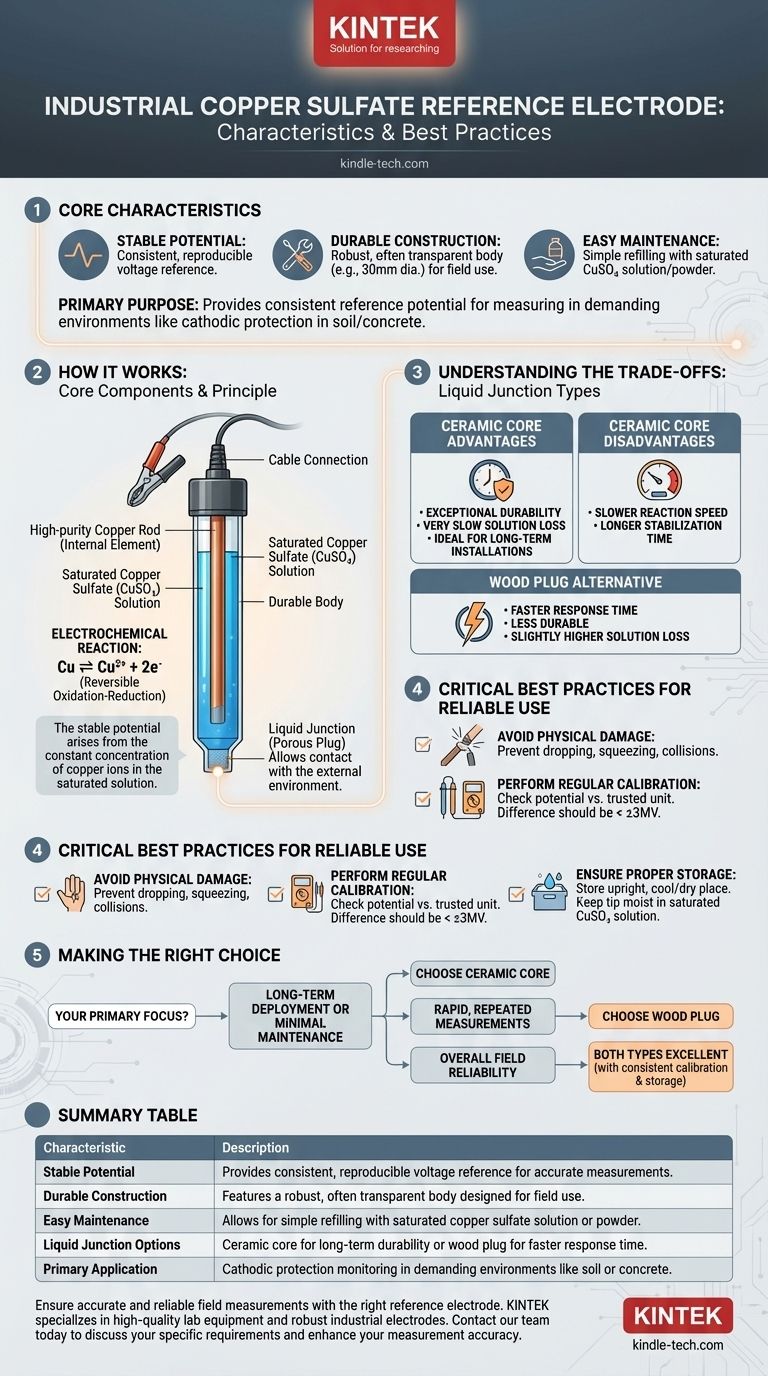At its core, an industrial copper sulfate reference electrode is a robust electrochemical half-cell designed for field use. It typically features a 30mm diameter transparent body, a central copper rod, and is filled with a saturated copper sulfate solution or powder. Its key characteristics are a stable and reproducible potential, resistance to polarization, and a design that emphasizes durability and long service life through easy refilling.
The primary purpose of this electrode is to provide a consistent, known voltage reference for measuring the electrical potential of other materials, particularly in demanding industrial environments like cathodic protection monitoring in soil or concrete. Its design prioritizes field reliability over laboratory-grade precision.

How it Works: Core Components and Principle
An industrial copper sulfate electrode's reliability stems from its simple and stable electrochemical design. Understanding its components is key to understanding its function.
The Internal Construction
The electrode consists of a high-purity copper rod serving as the internal element. This rod is housed within a durable, often transparent, body and is immersed in a saturated copper sulfate (CuSO₄) solution. The connection is made via an attached cable, usually terminated with an alligator clip for easy use in the field.
The Electrochemical Reaction
The electrode's stable potential is generated by the reversible oxidation-reduction reaction between the copper metal and copper ions in the solution (Cu ⇌ Cu²⁺ + 2e⁻). Because the solution is saturated, the concentration of copper ions remains constant, which in turn keeps the electrode's potential fixed and highly reproducible.
The Liquid Junction
A critical component is the liquid junction, typically a porous plug at the tip of the electrode made of wood or ceramic. This plug allows electrical contact (ionic flow) with the external environment (like soil or water) being measured, without allowing the internal copper sulfate solution to leak out rapidly.
Understanding the Trade-offs: Ceramic Core vs. Wood Plug
The choice of liquid junction material presents a direct trade-off between responsiveness and long-term durability.
The Ceramic Core Advantage
Electrodes with a ceramic core are known for their exceptional durability and very slow loss of the internal solution. This makes them ideal for long-term or permanent installations where minimal maintenance is crucial.
The Ceramic Core Disadvantage
The primary drawback of the ceramic core is a slower reaction speed. It may take slightly longer for the potential to stabilize when taking a measurement compared to other junction types.
The Wood Plug Alternative
A wood plug liquid junction generally offers a faster response time. However, it is typically less durable and may allow for a slightly higher rate of solution loss over time compared to a ceramic core.
Critical Best Practices for Reliable Use
Proper handling and maintenance are essential for ensuring the accuracy and longevity of the electrode. Misuse is a common source of measurement error.
Avoid Physical Damage
The electrode body, while robust, can be damaged. It is crucial to prevent damage from dropping, squeezing, or strong collisions, which can compromise the seals or the porous plug.
Perform Regular Calibration
Performance should be checked periodically. Measure the electrode's potential against another new or trusted reference electrode. An on-site potential difference between two healthy units should be very small, typically less than ±3MV. Significant deviation indicates a problem.
Ensure Proper Storage
When not in use, the electrode should be stored upright in a cool, dry place, away from direct sunlight. The tip should be kept moist, ideally by immersing it in a container with a small amount of saturated copper sulfate solution to prevent the porous plug from drying out and clogging.
Making the Right Choice for Your Goal
Selecting the correct junction type and applying proper maintenance is key to achieving reliable field measurements.
- If your primary focus is long-term deployment or minimal maintenance: Choose the ceramic core model for its superior durability and minimal solution loss.
- If your primary focus is rapid, repeated measurements: The slightly faster response of a wood plug model might be more suitable for your workflow.
- If your primary focus is overall field reliability: Both types are excellent, but consistent calibration and proper storage are the most important factors for accurate readings.
Ultimately, the industrial copper sulfate electrode is a trusted standard for its ability to provide a stable reference potential in challenging field conditions.
Summary Table:
| Characteristic | Description |
|---|---|
| Stable Potential | Provides a consistent, reproducible voltage reference for accurate measurements. |
| Durable Construction | Features a robust, often transparent body (e.g., 30mm diameter) designed for field use. |
| Easy Maintenance | Allows for simple refilling with saturated copper sulfate solution or powder. |
| Liquid Junction Options | Ceramic core for long-term durability or wood plug for faster response time. |
| Primary Application | Cathodic protection monitoring in demanding environments like soil or concrete. |
Ensure accurate and reliable field measurements with the right reference electrode. KINTEK specializes in high-quality lab equipment and consumables, including robust industrial electrodes designed for demanding environments. Our experts can help you select the perfect electrode for your cathodic protection or monitoring needs. Contact our team today to discuss your specific requirements and enhance your measurement accuracy.
Visual Guide

Related Products
- Copper Sulfate Reference Electrode for Laboratory Use
- Reference Electrode Calomel Silver Chloride Mercury Sulfate for Laboratory Use
- Rotating Platinum Disk Electrode for Electrochemical Applications
- Metal Disc Electrode Electrochemical Electrode
- Platinum Sheet Electrode for Laboratory and Industrial Applications
People Also Ask
- Where should the copper copper sulfate reference electrode be placed to obtain an accurate reading? Ensure Correct Structure-to-Soil Potential Measurement
- What are the advantages and disadvantages of the wood plug type copper sulfate reference electrode? Speed vs. Durability Explained
- What is a permanent copper/copper sulphate reference electrode? A Key Tool for Accurate Corrosion Monitoring
- What is the potential of copper sulfate reference electrode? A Stable +0.314 V Baseline for Field Measurements
- What are the performance characteristics of a copper sulfate reference electrode? Unmatched Stability for Field Corrosion Testing



















